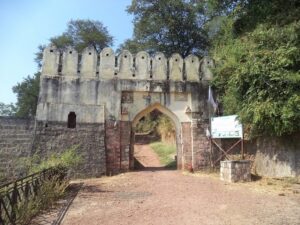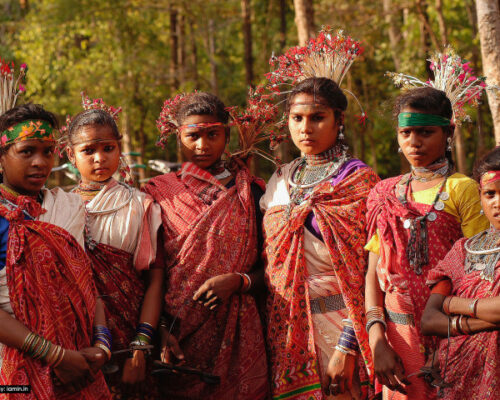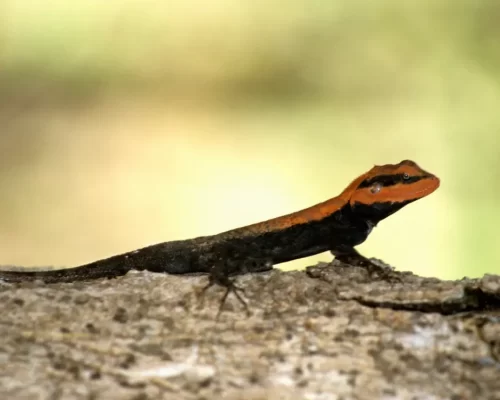Manikgarh, also known as Gadchandur is an ancient fort in Chandrapur district, Maharashtra. It is a hill fort 507 meters above sea level. The fort is in ruins and is frequented by wild animals that live in the vicinity, such as panthers and boars. Several monuments of historical importance are nearby. It was under the rule of Gonds of Chanda from the 9-16th century. Just a two-hour drive from Red Earth, our resort in Tadoba the Manikgarh Fort is a must-visit place near the Tadoba tiger reserve.
History:

Manikgarh fort in the Chandrapur district of Maharashtra was built by the last Mana Naga King – Gahilu. The Mana Nagas settled in this area around 9 CE. Earlier the fort was called Manikgarh after the patron deity of the Mana Nagas – Manikadevi – but later, this was shortened to Manikgad. According to the local legend the fort was built by a Gond king named Mankyal, so the name was changed to Manikgad. However, the beam at the entrance gate has a Naga image carved in relief and not the Gond emblem of a lion and an elephant. So this legend is most likely, not true.
The strong fortress of Manikgadh which is nearly 1,700 feet high and situated in an unreachable territory, was earlier held by the Gond Rajas of Chanda whose rule extended in the northern side to Nagpur and in the southern part almost up to the Godavari. They were independent till the end of the 16th century. Later they began to give nominal bonding to the Mughals, and then to the Marathas, to whom they finally surrendered in 1751 and lost the kingdom of Chanda.
If tradition is to be believed, the Gond rulers began their rule in the 9th century, though this seems to have been based mainly on local stories but have no evidence. Sirpur was the capital until the Rajas transferred the kingdom to Chanda in the 16th century. Gonds are one of the principal tribes of Central India today and retain their tribal customs, traditions and manners. Every year Gonds and other tribes gather in their thousands at the annual fair at Keslapur, a sylvan village.
Features of the Fort:
The fort was built of large black stones and was a formidable defence in its time. Barricade walls of the fort enclose a valley that has ruins of old buildings and storehouses. The outlines of the fort are visible against the rampart walls. The southern part of the fort, along with its supporting wall, collapsed.
There lies a cannon in the valley below that was likely mounted on that bastion that is destroyed. Unlike a cast-iron cannon, this cannon is made of several iron straps welded together. The gateway of the fort is intact.
The Queen’s palace is situated near a small dam with steps and a few bathing rooms. Two wooden pagodas were constructed by the Forest Department. The fort area is filled with shrubs and trees.
If you are a history buff, the Chandrapur district has a lot to offer. If you are on a vacation at the Tadoba Reserve, and relaxing at our resort in Tadoba, you can spend a day visiting the historical town of Chandrapur.
Here are some important historical forts in Chandra that you must visit:
Ballalpur Fort:

During 1437-62 AD, Ballalpur was the capital of the Gond King Khandakya Ballalshah. The fort that was built here on the eastern bank of the Wardha River is square in shape with walls and bastions. There are still two gates that are intact and are set at a right angle to each other. There is also a small rear gate on the riverside.
Chandrapur Fort:

The capital was shifted from Ballalpur to Chandrapur later and the Ballal kings built an extensive fort with high walls and projections. The fort had four impressive gates at four cardinal points. The original buildings are not there anymore but the gates and a portion of the wall still exists. Chandrapur was annexed by Raghuji Bhosale of Nagpur in the middle of the 18th century. Finally, the fort was captured by the Britishers in 1818 AD.
If you want to read more about the Historical town of Chandrapur you can read our blog 5 must-see places to visit in Tadoba. You can stay at Red Earth, our resort in Tadoba and enjoy a day trip to Chandrapur.



